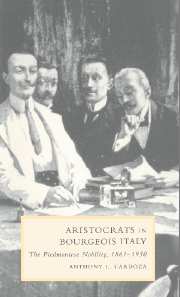Book contents
- Frontmatter
- Contents
- List of tables
- Acknowledgments
- Introduction
- 1 The making of the Piedmontese nobility: 1600–1848
- 2 The long goodbye: aristocrats in politics and public life: 1848–1914
- 3 Old money: the scale and structure of aristocratic wealth
- 4 Perpetuating an aristocratic social elite
- 5 The limits of fusion: aristocratic–bourgeois relations in nineteenth-century Piedmont
- 6 Retreat and adaptation in the twentieth century
- Bibliography
- Index
- CAMBRIDGE STUDIES IN ITALIAN HISTORY AND CULTURE
1 - The making of the Piedmontese nobility: 1600–1848
Published online by Cambridge University Press: 03 November 2009
- Frontmatter
- Contents
- List of tables
- Acknowledgments
- Introduction
- 1 The making of the Piedmontese nobility: 1600–1848
- 2 The long goodbye: aristocrats in politics and public life: 1848–1914
- 3 Old money: the scale and structure of aristocratic wealth
- 4 Perpetuating an aristocratic social elite
- 5 The limits of fusion: aristocratic–bourgeois relations in nineteenth-century Piedmont
- 6 Retreat and adaptation in the twentieth century
- Bibliography
- Index
- CAMBRIDGE STUDIES IN ITALIAN HISTORY AND CULTURE
Summary
A remarkably consistent image of Piedmont's titled nobility emerges from contemporary accounts of both the eighteenth and nineteenth centuries, an image which suggests they were respected, but seldom loved. Observers invariably commented on the arrogance, bigotry, narrow-mindedness, and self-satisfaction of the second estate. In the 1760s, for instance, Giuseppe Baretti noted an “excessive pride of birth” among Piedmontese aristocrats, the majority of whom “disdain any familiarity” with persons of less exalted lineage. On those rare occasions when they agreed to speak to outsiders, Baretti claimed that “their kindness is such a bizarre mixture of courtesy and haughtiness that it is impossible for a man of substance not to be offended.” Nearly a century later, Vincenzo Gioberti observed in the 1840s how “the concept of their own superiority is inborn in the Piedmontese aristocrats; they make you feel it although they are courteous; they dominate while they bow; they show that they are your masters while professing themselves your servants.” In the 1860s, one of the nobility's most distinguished figures, Massimo d'Azeglio, provided a striking confirmation of these outsiders' impressions:
My dear reader, I feel sure that more than once it has fallen to your lot to have to do with someone who, in his attitude towards you, failed in nothing due to courtesy, who uttered no word to which you could object without being ridiculous or absurdly punctilious, and yet at the same time gave forth from his whole person such a clear “keep your distance,” such an obvious “I'm what I am and you don't count,” that, as there was reason to get angry and no possibility of putting up with it, one simply longed to get out of range, and, if possible, never let oneself be caught again.[…]
- Type
- Chapter
- Information
- Aristocrats in Bourgeois ItalyThe Piedmontese Nobility, 1861–1930, pp. 13 - 54Publisher: Cambridge University PressPrint publication year: 1998



